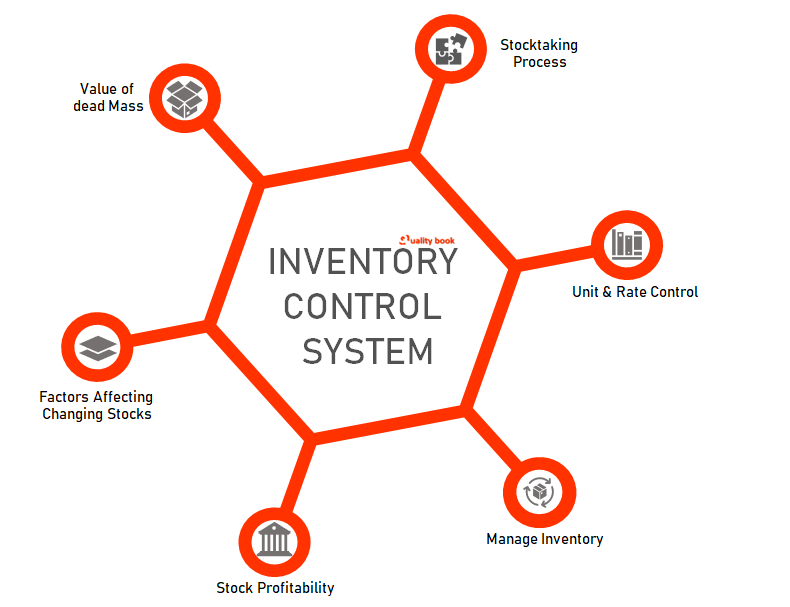Inventory Control System |Each store shall have the systems and procedures used to control stock. Regardless of the system, calculations are important and accurate stock counts are vital.
Although there are many stock control systems available, it is pertinent to know what information should be provided, efficient stock control system:

Unit control
- Support units in stock by size, style, and color for each classification.
- Entities must already be committed to stock units based on size, style, and color in order for the classification to take place.
- Make arrangements that can be done automatically by systematic classification.
- Identify best/weakest workers.
- Reorder published time by item, recommended amount and capital cost.
- Comparison of the best planned range by item, especially for baselines (anything less than the modern method is very difficult to achieve).
The unit inventory control system should be able to integrate open plan to plan. Including dollar control, classification by planned and advanced commitments – that is, you will convert units to cost dollars (or retail inventory depending on what you operate).
Rate control
To measure the objective of dollar control, as follows:
- Amount invested in each product line.
- Stock turn per product line
- Total profit
Manage inventory.
There are so many issues in inventory control system. You need to be aware of when monitoring and controlling your stock and employees.
These topics include:
- How can business received from different suppliers be handled?
- What can be listed during non-store hours when stores are open?
- What level of disruption or loss is acceptable? When do you know how this level is crossed?
- Who is responsible for letting in and out of the store?
Determine Stock Profitability
There is no best way to determine stock profitability. The key to selecting the method is how well the relationship is identify:
- Stock turn
- Total profit
- Cost
- Is being imports.
Stock turn is the frequency that a stock is sold or turned over. They are usually expressed in terms of one year, but in some businesses. This period may be express in terms of less than one year.
Factors Affecting Changing Stock
Some retailers focus on fast sellers out of stock and remove the seller quickly. Others have few fast sellers but many slow sellers that drag their market shares down.
Slow-selling traders are expensive and should be removes from your range. In some cases you may need to carry certain lines to maintain your credibility and/or complete the product range.
Another factor affecting the stock market is excess inventory. Keep as much stock as possible without losing efficient retailers. These provide a level playing field to fast sellers and ensure they never run out of stock. They also reduce or eliminate the back-up stock of slow lines.
The key to net profit is a high return on investment rate. Sadly, a buyer won’t be right every time and sometimes there will be slow movers in your range. This can be offset by carefully selecting replacement lines or new merchandising lines that have a better chance of sales.
Value of dead mass
To identify the cost of dead money, first consider the cost of:
- How much space is occupied by the stock.
- Damaged by damage or loss.
- Interest on money attached to shares.
- A tired-looking stock which damages the image of your shop.
- Most of all – profit loss selling good stocks.
- Dead stock measure
Consider the following example for Inventory Control system:
If you own $8,000 worth of stocks at price. Your overall profit margin was 33-1/3%. It should then be sold for $12,000.
Decrease sales of $8,000 to $12,000.
The dead stock value is $4,000 (gross profit).
» If you rotate your stock 4 times a year
» Dead stock probably 4 x $4,000 = lost
» $16,000 potential net profit in one year.
You cannot afford to have dead stock. Don’t hesitate to price it to sell, even if it means sell it!
Implementation of Stocktaking Process
Stock take provides a true measurement of the store’s progress. On the surface, it looks like you are selling all the stocks you have select, while in reality some of them are being stolen or damaged and thrown away. For this reason, stock taking is an important activity for any retailer.
Whether stock shakes are conducted quarterly, semiannually, or annually, precision is required. Bullshit stocktaking takes time to find junk that may not be in actual contraction or on the part of stocks, only on paper.
There are several decisive steps to take before and after the stock take for you and your employees.
By ensuring that employees are awake, and utilizing stores’ stacking procedures, the stock take improves the processability of the process and the accuracy of the end results.